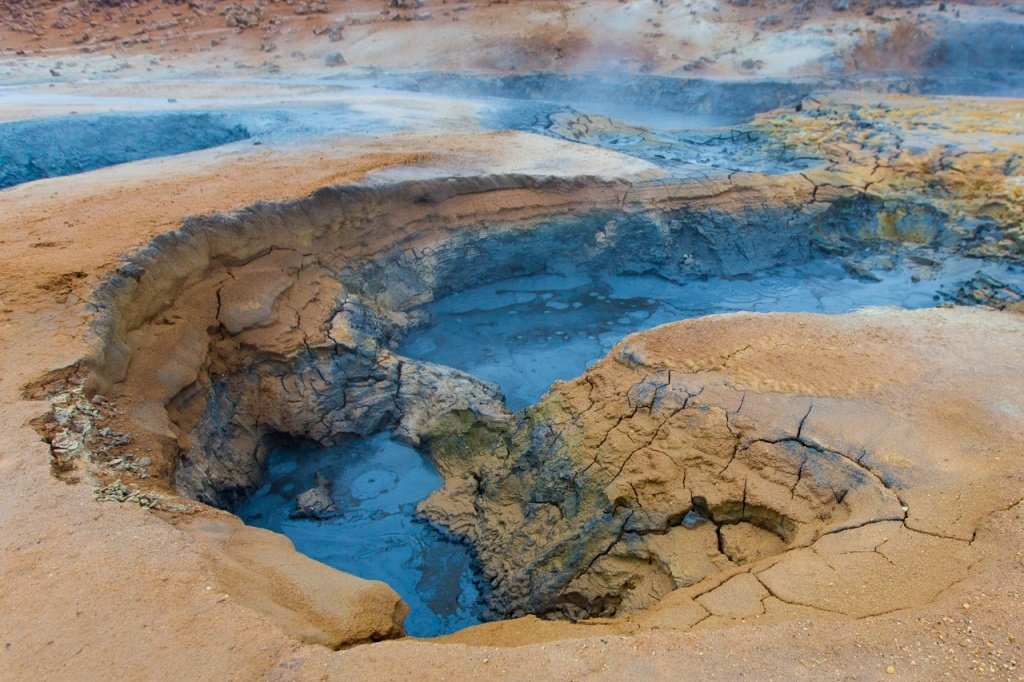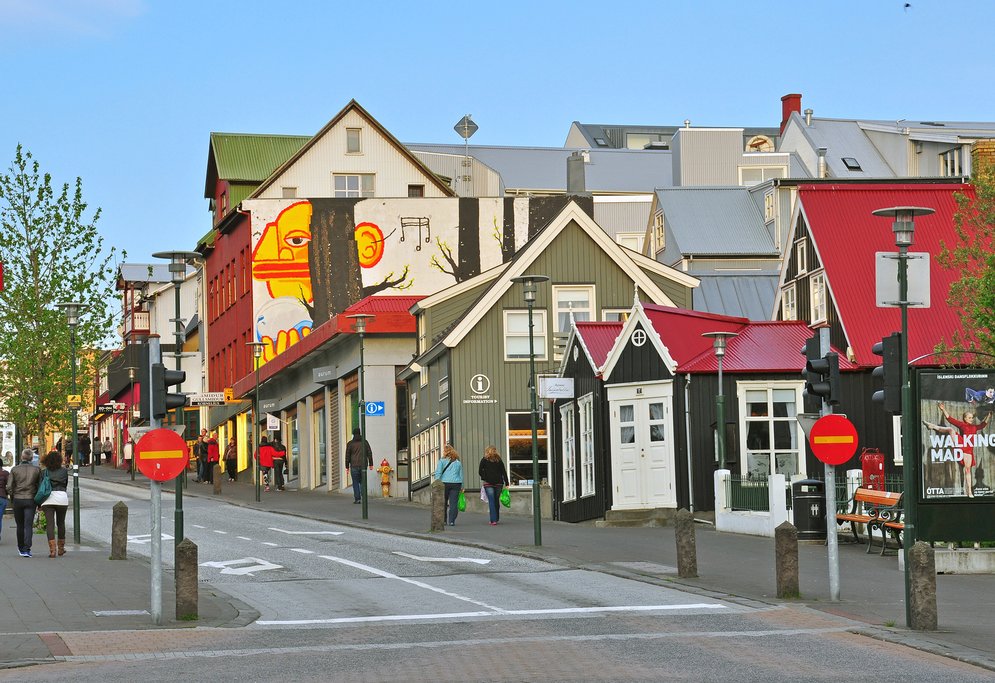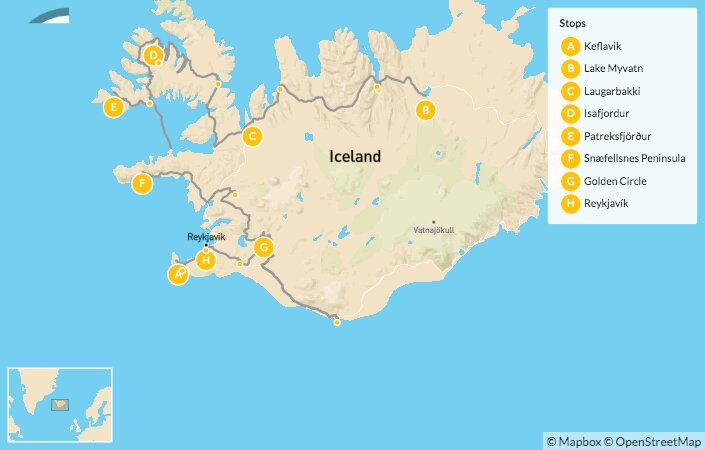Highlights
- Soak in the healing lagoons of Mývatn Nature Baths
- Tour Miðfjorður fjord and watch playful seals in the ocean waters
- See endless views from the summit of Kaldbakur Mountain
- Walk black-sand beaches and explore sea caves at Reynisfjara Beach
Brief Itinerary
| Day | Highlights | Overnight |
|---|---|---|
| Day 1 | Arrive in Keflavík, Transfer to Akureyri, Drive to Lake Mývatn | Lake Mývatn |
| Day 2 | Hverir, Dettifoss & Jökulsárgljúfur, Asbyrgi Canyon, Whale Watching | Lake Mývatn |
| Day 3 | Drive to Laugarbakki | Laugarbakki |
| Day 4 | Drive to Ísafjörður, Hvitanes, Litlibaer, Valagil | Isafjordur |
| Day 5 | Kaldbakur Mountain Hike | Isafjordur |
| Day 6 | Drive to Patreksfjörður, Hrafnseyri, Dynjandi & Bildudalur | Patreksfjörður |
| Day 7 | Raudasandur, Breidavik, Látrabjarg Cliffs, Ferry to Stykkisholmur | Snæfellsnes Peninsula |
| Day 8 | Kirkjufellsfoss, Djupalonsandur Black-Sand Beach, Lava Fields & Cliffs | Snæfellsnes Peninsula |
| Day 9 | Golden Circle, Þingvellir National Park | Golden Circle |
| Day 10 | Geysir Geothermal Area, Gullfoss Waterfall, Friðheimar Farm | Golden Circle |
| Day 11 | Drive to Vík, Waterfalls, Dyrholaey Arch, Reynisfjara & Reynisdrangar | Golden Circle |
| Day 12 | Drive to Reykjavík, Reykjadalur Valley Hike | Reykjavík |
| Day 13 | Krysuvik, Gunnuhver, Bridge Between Continents, Depart Reykjavík |
Detailed Itinerary
Day 1: Arrive in Keflavík, Transfer to Akureyri, Drive to Lake Mývatn

Welcome to Iceland! After your initial flight into Keflavík, you'll transfer to the city of Akureyri via Reykjavík airport. From here, pick up your rental car and begin your drive along Iceland's Ring Road, or Route 1. Your first stop will be Goðafoss or the "Waterfall of the Gods." Legend has it, the waterfall was named when a local chieftain made the decision to convert the country from the old Nordic gods to Christianity, and in order to prevent war, he threw the old gods into the falls. It's an easy hike from the road to a closer view of the falls, or you can take a small footpath down to the water's edge.
Your next stop is Grjótagjá Cave, a small lava cave that contains a natural geothermal spring, and one of the locations where the series "Game of Thrones" was filmed. You can walk inside the cave to see the hot pool, but use caution as the water tends to run extremely hot. From here, head to Hverfjall, a large, circular explosion crater and one of Iceland's most beautiful and symmetrical craters of its kind. It is estimated that the crater was created during a volcanic explosion and is close to 3,000 years old.Day 2: Hverir, Dettifoss & Jökulsárgljúfur, Asbyrgi Canyon, Whale Watching

Visit Asbyrgi Canyon, which local folklore claims was created by the footprint of Odin's eight-legged horse. The walls of the canyon are more than 300 feet (100 m) high in some places, offering spectacular views. Or if you'd prefer some wildlife viewing, make the drive to the coastal town of Húsavik, where you can hop on a tour that offers up-close sightings of whales, porpoises, and seabirds. Unlike other regions where you must sail farther into the sea to view whales, Húsavik often has marine life just a few minutes from the harbor. Return to Lake Mývatn for the evening before continuing your travels tomorrow.
Day 3: Drive to Laugarbakki

Head to the quaint village of Laugarbakki today, which is located on the Miðfjarðará River. The community itself is quite small, with less than 100 residents, but the surrounding areas are vast, with plenty of sights to see. Start at Kolugljufur Canyon, where you'll find the breathtaking Kolufoss waterfall. You can walk across a nearby bridge to get closer, taking in the endless views of the high cliffs and the river running through the gorge.
Adjacent to Laugarbakki is the village of Hvammstangi, where, in the summer months, you can take guided private seal-watching tours. Tour around Miðfjorður fjord, and catch views of the playful seals in their natural environment. Hvammstangi is also home to the Icelandic Seal Center, a research and exhibition facility that investigates the lives of the seals in the area. Here, you can learn about the various species of seals in Iceland, as well as the other wildlife that inhabits the northern regions.
Visitors to this region can also explore various sights of the Vatnsnes Peninsula, stopping at local landmarks such as Borgarvirki fortress and Hvitserkur sea stack. And if the supernatural interests you, take a side trip to the Witchcraft Museum in the town of Hólmavík. The exhibits tell the story of the witch craze in Iceland in the 17th century and how witchcraft is presented in Icelandic folklore. Learn about historic witchcraft cases and about different witchcraft practices! Spend tonight relaxing at your hotel in Laugarbakki.
Day 4: Drive to Ísafjörður, Hvitanes, Litlibaer, Valagil

Continue to the Westfjords and to the village of Ísafjörður, known for its historic houses, maritime history, and breathtaking scenery. The largest town in the region, its central location makes it a great landing pad in between your exploration of the area. After checking in at your accommodation, head to Hvitanes, one of Iceland's most accessible seal colonies. You'll be able to observe large numbers of harbor seals as they relax on the rocks just a short distance from shore.
Next, visit Litlibaer, a historic turf farmstead that was built in 1895, and at just over 300 square feet (29 sq m) one of the smallest farms in Iceland. The property was taken over by the National Museum of Iceland in 1969, and it now functions as a museum, with exhibitions on early life in Iceland. The museum also has a café, where you can grab a coffee or try one of their specialty waffles.
Travelers who are interested in wildlife conservation should also make the quick drive to Sudavik, home to the Arctic Fox Center, a non-profit research center where you can learn about the history of the Arctic fox. Later, end your day with a visit to Alftafjordur fjord and the waterfalls of Valagil. Formed from layers of ancient lava, the ravine is said to be named after the falcons, or valur, that used to nest there. From the parking area near the road, take an easy 1.25-mile (2 km) hike through the natural beauty of this valley and to the falls.
Day 5: Kaldbakur Mountain Hike

Get out and get active today with a summit of Kaldbakur Mountain, the highest peak in the Westfjords. This guided hike starts in Ísafjörður, where you'll take a van to the trailhead at Alftamyrarheidi mountain pass. The hike to the top takes approximately three to four hours, and is fairly strenuous, with a steady ascent and zig-zagging trails. Once you reach the top, you'll be rewarded with unparalleled views of the surrounding landscapes, including the fjord, mountains, and distant beaches. Enjoy your last night in Ísafjörður before continuing your travels tomorrow.
Day 6: Drive to Patreksfjörður, Hrafnseyri, Dynjandi & Bildudalur

This morning, your destination will be the town of Patreksfjörður. Before you leave, however, enjoy a walking tour of Ísafjörður, where you can learn more about the history and culture of the community. You can visit the Westfjords Heritage Museum, where you'll find exhibits on the town's maritime history, or stop in at the town's old hospital, which was converted into a cultural center and has photos and town archives for viewing.
Chat with a local specialist who can help organize your trip.
Day 7: Raudasandur, Breidavik, Látrabjarg Cliffs, Ferry to Stykkisholmur

It's off to the Snæfellsnes Peninsula, one of the most beautiful regions of western Iceland. Your first destination is Raudasandur Beach, a remote stretch of sand made popular by its unusual color. The orange-pink sands come from pulverized scallop shells, and at low tide, you'll notice the contrast between the mountain cliffs and the blue ocean. The beach can be accessed via nearby Lambavatn Farm, which sits toward the western end of the beach, or from the community of Saurbaer.
Day 8: Kirkjufellsfoss, Djupalonsandur Black-Sand Beach, Lava Fields & Cliffs

Take the ferry back to the mainland and continue your tour of the Snæfellsnes Peninsula. Stop at Kirkjufellsfoss waterfall, where you'll see Mount Kirkjufell in the background—one of Iceland's most photographed peaks. You'll also want to make a quick detour to Saxholar Crater, where you can stretch your legs with a walk up the stairs that take you right to the top of the crater and great views of the countryside.
Day 9: Golden Circle, Þingvellir National Park

The park is also home to the Silfra fissure, created by the separation of the North American and Eurasian tectonic plates cutting through Iceland. Filled with glacial water that has been filtered underground for decades and with nearly 400 feet (120 m) of visibility, it is one of the clearest bodies of water on earth. You can view the fissure from land or take a snorkel tour. Before leaving the park, take a moment to visit historic Law Rock, where Viking chieftains from all over the country met once a year to discuss laws and issues.
This afternoon, stop at Hraunfossar and Barnafoss waterfalls. Hraunfossar, or "lava waterfalls," is an unusual stretch of tiny waterfalls arising from springs of subterranean water seeping through the lava. They have been protected since 1987. Nearby is Barnafoss (Children's Waterfall), whose name comes from a legend about two children who drowned in the falls.
Day 10: Geysir Geothermal Area, Gullfoss Waterfall, Friðheimar Farm

Day 11: Drive to Vík, Waterfalls, Dyrholaey Arch, Reynisfjara & Reynisdrangar

Visit some of Iceland's most impressive waterfalls today, starting just off the Ring Road at the base of the Eyjafjallajokull glacier. Here you'll find Seljalandsfoss waterfall and the river Seljalandsa. The unusual thing about this waterfall, which cascades from a height of nearly 200 feet (60 m), is that it is one of the only known waterfalls you can actually walk behind. Access is an easy few-minute walk from the parking lot, and you can stand in a cave under the cliffs and watch the water roaring in front of you.
Just west of Seljalandsfoss is the waterfall of Gljufrabui, which sits in its own small canyon and can be accessed via nearby Hamragardar Farm. Then, head to nearby Skógafoss, which translates to "forest waterfall." The waters here often create dazzling rainbows, making it one of Iceland's most photographed falls. From here, continue to Dyrholaey Arch. This nearly 400-foot (120 m) promenade showcases some of the most amazing panoramas of the southern coast. At the top, you can see portions of Mýrdalsjökull glacier, and endless coastlines of black-sand beaches.
Your last stop today will be Reynisfjara Beach. This stretch of black volcanic sand is most known for the Reynisdrangar sea stacks, huge basalt hexagonal columns that are the nesting grounds for various seabirds. You can walk the beach, and if you head around the cliffs facing the ocean, you'll see a couple of large caves worth exploring. After your beach visit, overnight in the town of Vík, where you can enjoy dinner at a local restaurant and explore the town a bit.Day 12: Drive to Reykjavík, Reykjadalur Valley Hike

Your last full day in Iceland starts with a visit to Reykjadalur or "Steam Valley," located just outside the town of Hveragerdi. Although the last eruption here was over 2,000 years ago, the area is still very active with steaming mud pools, fumaroles, a hot river, and billows of steam coming out of the mountainside. You can hike to the hot river, which takes about an hour, and visitors are permitted to bathe here. Be aware that some of the hot springs here have temperatures close to boiling, so stay on the marked trail.
This afternoon, you'll arrive in Reykjavík, where you'll overnight. After checking in at your hotel, you can step out and see more of the city. Start with a walk through the downtown area, which has shopping and beautiful street art. Then, head toward the waterfront to see the Sun Voyager, a metal sculpture that replicates a Viking ship, or Hallgrimskirkja Church, where you can climb the tower that overlooks the whole city. There are also several museums worth visiting, including the Northern Lights Center, Saga Museum, Marine Museum, and the Whales of Iceland Exhibition.
If you'd like to get a closer look at Iceland's marine life, you can join a whale watching tour from Reykjavík's harbor. Or, just explore the various shops and restaurants. The shopping street of Skólavörðustígur has several wool and handicraft stores, and boutiques featuring local designers. Have dinner at one of the city's many fine restaurants before retiring for the evening.
Day 13: Krysuvik, Gunnuhver, Bridge Between Continents, Depart Reykjavík

It's departure day from Iceland today, but if you have some time before your flight, visit a few more interesting sights. Go by Krysuvik volcanic area, which spans 135 square miles (350 sq km) and is home to Seltun, a colorful geothermal area with bubbling mud pots and hot springs. Then, stop at Gunnuhver, one of the most active geothermal areas of Iceland. Legend has it, the region was named after a female ghost called Gunna, who caused havoc in the area hundreds of years ago.
Farther down the road is the Reykjanes Lighthouse which offers great views of the area and the Valahnukur Cliffs, which are abundant with birdlife. Make your last stop at the Bridge Between Continents, where you can cross the bridge between the Mid-Atlantic's continental plates and look down at the gap below. Afterward, drive back to Keflavík airport where you'll return your rental car and hop on your flight home. Safe travels!
More Iceland Itineraries
Looking for more inspiration for your trip to Iceland? Check out these other Iceland itineraries, see additional options for 13-day Iceland tours, or learn about the best time to visit Iceland.


